Craniodental and humeral morphology of a new species of Masrasector (Teratodontinae, Hyaenodonta, Placentalia) from the late Eocene of Egypt and locomotor diversity in hyaenodonts
- PMID: 28422967
- PMCID: PMC5396875
- DOI: 10.1371/journal.pone.0173527
Craniodental and humeral morphology of a new species of Masrasector (Teratodontinae, Hyaenodonta, Placentalia) from the late Eocene of Egypt and locomotor diversity in hyaenodonts
Abstract
Hyaenodonta is a diverse clade of carnivorous mammals that were part of terrestrial faunas in the Paleogene of Eurasia and North America, but the oldest record for the group is Afro-Arabian, making the record there vital for understanding the evolution of this wide-spread group. Previous studies show an ancient split between two major clades of hyaenodonts that converged in hypercarnivory: Hyainailourinae and Hyaenodontinae. These clades are each supported by cranial characters. Phylogenetic analyses of hyaenodonts also support the monophyly of Teratodontinae, an Afro-Arabian clade of mesocarnivorous to hypercarnivorous hyaenodonts. Unfortunately, the cranial anatomy of teratodontines is poorly known, and aligning the clade with other lineages has been difficult. Here, a new species of the phylogenetically controversial teratodontine Masrasector is described from Locality 41 (latest Priabonian, late Eocene) from the Fayum Depression, Egypt. The hypodigm includes the most complete remains of a Paleogene teratodontine, including largely complete crania, multiple dentaries, and isolated humeri. Standard and "tip-dating" Bayesian analyses of a character-taxon matrix that samples cranial, postcranial, and dental characters support a monophyletic Masrasector within Teratodontinae, which is consistently placed as a close sister group of Hyainailouridae. The cranial morphology of Masrasector provides new support for an expanded Hyainailouroidea (Teratodontinae + Hyainailouridae), particularly characters of the nuchal crest, palate, and basicranium. A discriminant function analysis was performed using measurements of the distal humerus from a diverse sample of extant carnivorans to infer the locomotor habits of Masrasector. Masrasector was assigned to the "terrestrial" locomotor category, a result consistent with the well-defined medial trochlear ridges, and moderately developed supinator crests of the specimens. Masrasector appears to have been a fast-moving terrestrial form with a diverse diet. These specimens considerably improve our understanding of Teratodontinae, an ancient member of the Afro-Arabian mammalian fauna, and our understanding of hyaenodont diversity before the dispersal of Carnivora to the continent near the end of the Paleogene.
Conflict of interest statement
Figures
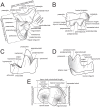
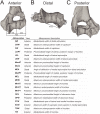
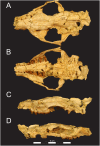

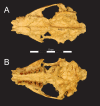







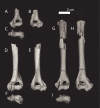

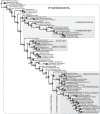
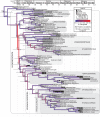
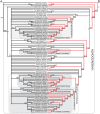


Similar articles
-
The first hyaenodont from the late Oligocene Nsungwe Formation of Tanzania: Paleoecological insights into the Paleogene-Neogene carnivore transition.PLoS One. 2017 Oct 11;12(10):e0185301. doi: 10.1371/journal.pone.0185301. eCollection 2017. PLoS One. 2017. PMID: 29020030 Free PMC article.
-
Hyainailourine and teratodontine cranial material from the late Eocene of Egypt and the application of parsimony and Bayesian methods to the phylogeny and biogeography of Hyaenodonta (Placentalia, Mammalia).PeerJ. 2016 Nov 10;4:e2639. doi: 10.7717/peerj.2639. eCollection 2016. PeerJ. 2016. PMID: 27867761 Free PMC article.
-
New specimens of the rare taeniodont Wortmania (Mammalia: Eutheria) from the San Juan Basin of New Mexico and comments on the phylogeny and functional morphology of "archaic" mammals.PLoS One. 2013 Sep 30;8(9):e75886. doi: 10.1371/journal.pone.0075886. eCollection 2013. PLoS One. 2013. PMID: 24098738 Free PMC article.
-
Bird evolution in the Eocene: climate change in Europe and a Danish fossil fauna.Biol Rev Camb Philos Soc. 2006 Nov;81(4):483-99. doi: 10.1017/S146479310600707X. Epub 2006 Aug 8. Biol Rev Camb Philos Soc. 2006. PMID: 16893476 Review.
-
A new fossil from the Jurassic of Patagonia reveals the early basicranial evolution and the origins of Crocodyliformes.Biol Rev Camb Philos Soc. 2013 Nov;88(4):862-72. doi: 10.1111/brv.12030. Epub 2013 Feb 28. Biol Rev Camb Philos Soc. 2013. PMID: 23445256 Review.
Cited by
-
The first hyaenodont from the late Oligocene Nsungwe Formation of Tanzania: Paleoecological insights into the Paleogene-Neogene carnivore transition.PLoS One. 2017 Oct 11;12(10):e0185301. doi: 10.1371/journal.pone.0185301. eCollection 2017. PLoS One. 2017. PMID: 29020030 Free PMC article.
-
New data on the mammalian fauna from the late middle Eocene (MP 15-16) of Mazaterón (Soria, Spain): The youngest presence of the genus Prodissopsalis (Hyaenodonta, Hyaenodontidae) in Europe.Anat Rec (Hoboken). 2025 Jun;308(6):1769-1782. doi: 10.1002/ar.25223. Epub 2023 Apr 14. Anat Rec (Hoboken). 2025. PMID: 37060198 Free PMC article.
-
The first North American Propterodon (Hyaenodonta: Hyaenodontidae), a new species from the late Uintan of Utah.PeerJ. 2019 Nov 22;7:e8136. doi: 10.7717/peerj.8136. eCollection 2019. PeerJ. 2019. PMID: 31772846 Free PMC article.
References
-
- Rasmussen DT, Gutiérrez M. A mammalian fauna from the late Oligocene of northwestern Kenya. Palaeontographica, Abt A. 2009;288: 1–52.
-
- Werdelin L. Carnivora In: Werdelin L, Sanders W, editors. Cenozoic Mammals of Africa. Berkeley: University of California Press; 2010. pp. 609–663.
-
- Solé F, Falconnet J, Yves L. New proviverrines (Hyaenodontida) from the early Eocene of Europe; phylogeny and ecological evolution of the Proviverrinae. Zool J Linn Soc. 2014;171: 878–917.
-
- Mellett JS. Paleobiology of North American Hyaenodon (Mammalia, Creodonta). Contributions to Vertebrate Evolution. 1977;1: 1–134.
-
- Savage RJG. Megistotherium, gigantic hyaenodont from Miocene of Gebel Zelten, Libya. Bull Br Mus (Geol). 1973;22: 483–511.
MeSH terms
LinkOut - more resources
Full Text Sources
Other Literature Sources

